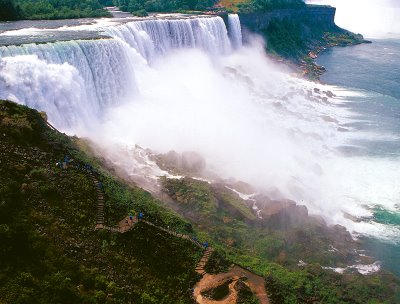 This photo was taken from an observation tower on the American side of Niagara. As the glaciers retreated in the upper Midwestern U.S. some 10,000 years ago, the water from Lake Erie began to flow into the Lake Ontario basin over the Niagara escarpment, a large shelf of rock which stretches from Quebec, Canada to Minnesota. The water eventually cut a trench into the escarpment, forming the Niagara River. Niagara Falls is where the trench cutting has stalled for the last hundred years or so.
This photo was taken from an observation tower on the American side of Niagara. As the glaciers retreated in the upper Midwestern U.S. some 10,000 years ago, the water from Lake Erie began to flow into the Lake Ontario basin over the Niagara escarpment, a large shelf of rock which stretches from Quebec, Canada to Minnesota. The water eventually cut a trench into the escarpment, forming the Niagara River. Niagara Falls is where the trench cutting has stalled for the last hundred years or so.For the last 100 years or so, water has been diverted from the river before it reaches the falls and is used to power hydroelectric plants. At night and during the tourist off-season, the volume of water passing over the falls is less than half of what it would be naturally. This has reduced the distance that the falls erode from nearly four feet to just a few inches each year.
It’s good for tourism that the falls are basically in the same place they’ve been for the last century and that a large portion of the U.S and Canada has a reliable supply of electric energy. But boy, wouldn’t it be something to see the falls flowing at full power?
Click on picture to enlarge. Photograph © 2006 James Jordan.




2 comments:
They are amazing to see even with the reduced flow. I did not realise the water diversions had such a dramatic effect.
I visited Pittsburgh about three years ago, but didn't have time to see the falls. I was planning that on my next trip, which was cancelled.
Thanks for the info. I didn't know any of that about the falls, until now.
Post a Comment